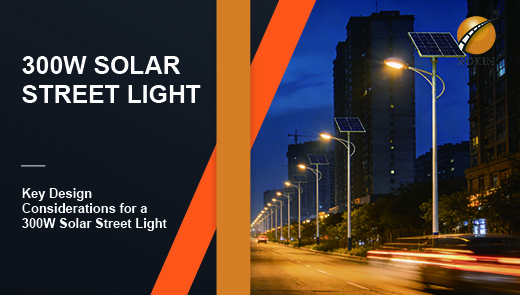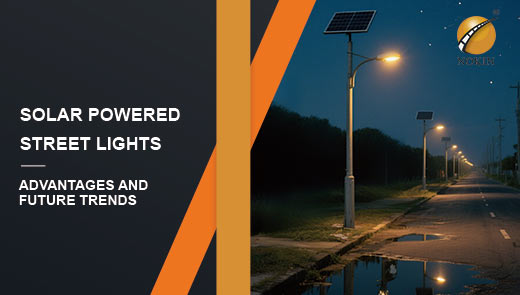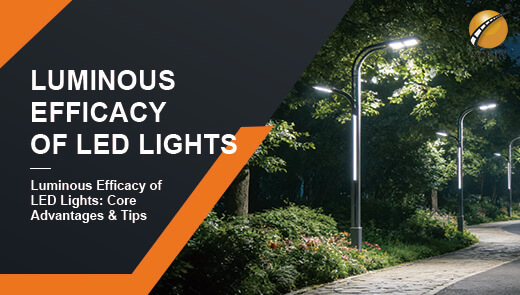Flood Light vs Street Light: Key Differences, Applications, and How to Choose
In the outdoor lighting system, flood light and street light are the two core equipment, which jointly guard the safety and convenience at night, but there are essential differences between the two in design, function, and application scenarios. For outdoor lighting planners, a clear understanding of the differences between the two is a prerequisite for rational selection -- this not only ensures that the lighting effect is up to standard, but also in cost control and energy savings to achieve the optimal configuration. In this paper, we will start from the definition, analyze the core differences between the two, introduce the applicable scenarios, and provide scientific selection methods for lighting program development reference.
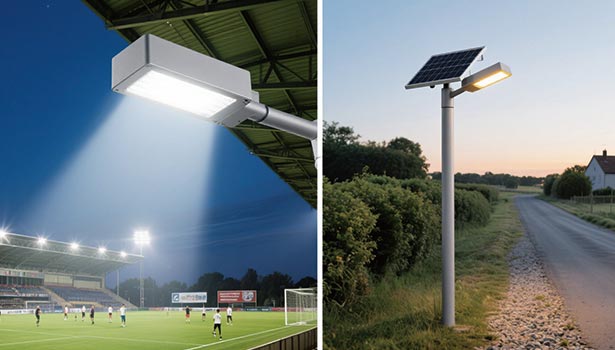
Definition of LED Floodlight and Street light
LED Floodlight
LED Floodlight takes safety and security as the core design goal, focusing on high-intensity, wide-range light coverage, which can eliminate the safety hazards brought by darkness at night. It is used in a wide range of scenarios: in large parking lots, it can illuminate the vehicle parking area to avoid bumping or falling; street corners and other complex areas of human mobility, the light can dispel the darkness and help pedestrians identify the dangers; floodlights installed in front of the residence, not only to facilitate the residents to travel at night, but also to deter suspicious people and enhance security.
LED Street Lights
LED street lights are outdoor lighting fixtures designed specifically for the public sector, with distinctive public attributes, the service object for the general public. The most typical application is the transformation of municipal street lighting: when the old incandescent lights are eliminated due to poor lighting effects and high energy consumption, municipal departments will uniformly replace them with LED street lights. These street lights are arranged along sidewalks and streets, and when lit at night, they illuminate the road for pedestrians and provide a clear view for vehicles, ensuring the safety of the entire neighborhood and benefiting all road users.
Flood Light VS Street Light: What Is the Difference?
Purpose of Lighting
Floodlights have a specific purpose of illumination, acting as “light cluster emitters” to illuminate a specific target area. For example, in sports events, the floodlights around the soccer stadium can cover the entire stadium, allowing players to clearly determine the ball path, the audience to see the game; large outdoor activities, it focuses on the stage or the core area, to ensure that the activities are carried out smoothly; in the field of security, it can light up the scope of the monitoring, so that the suspicious behavior has nothing to hide.
Street lighting purpose is more macro, to the road and sidewalk as the core, through a continuous and stable light for pedestrians and vehicles at night to provide basic protection, reduce the probability of traffic accidents. For example, the street lights on the city's main roads form light bands, guiding vehicles to travel in an orderly manner to protect the safety of pedestrians.
Light Distribution
Floodlights is the wide beam angle, usually between 60° and 120°, which covers a large area like a “big net” and is suitable for high-intensity lighting. For example, when a construction site is being worked on at night, the wide beam of a floodlight can illuminate the entire site, Allow workers to see details such as steel bar connections and concrete pouring to ensure construction safety and progress.
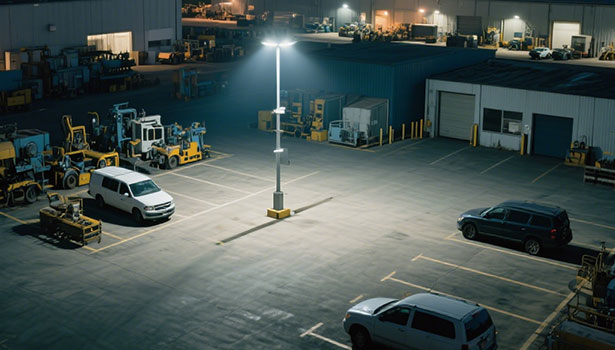
Street lights have a narrower beam, generally between 30° and 60°, and the light distribution is carefully designed to project mainly in the direction of the road extension. This design not only ensures adequate road lighting, but also reduces the spread of light to the surrounding area and reduces light pollution. For example, the street light near the residential area, the light is concentrated on the road surface, will not be too much irradiation of the residents at home, to avoid affecting the rest.
Installation Height
Floodlights are installed at a low height, usually between 2 and 5 meters, to focus the light precisely on the target area. For example, floodlights in private courtyards are usually installed at a height of about 3 meters, just enough to illuminate the flowers, tables and chairs in the courtyard, without wasting light, but also to create a cozy atmosphere and facilitate activities.
Street lights are mounted on high poles, commonly between 6 and 12 meters high, to provide extensive coverage of roads and sidewalks. This height allows the light to spread farther and ensures that multiple street lights are connected to form a continuous illumination belt, avoiding light blind spots when vehicles are traveling. For example, if a street light on a secondary road in a city is installed on an 8-meter high pole, the light can cover a 15- to 20-meter wide roadway to meet the lighting needs.
Power
|
Fixture Type |
Power Range |
Power Selection Criteria |
Typical Application Examples |
|
Floodlight |
10W–500W |
Mainly based on the size of the lighting area; larger areas require higher power |
30W for small yards, 300W for large freight yards |
|
Street Light |
30W–120W |
Depends on pole height and road width; higher poles and wider roads require higher power |
50W for 6m poles, 100W for 8m poles |
Energy Efficiency
LED floodlights are energy efficient, consuming more than 60% less power than traditional incandescent lights at the same brightness. For example, the lighting effect of a 100W LED floodlight is comparable to that of a 250W traditional floodlight, with power consumption reduced by nearly 60%, resulting in significant savings in electricity costs over the long term.
LED street lights are also energy efficient, compared with traditional high-pressure sodium lights, energy consumption is reduced by 50% to 70%. Data shows that replacing LED street lights on major roads in cities can save considerable electricity costs per kilometer of road per year, which not only reduces the city's operating costs, but also reduces energy waste, in line with the concept of energy saving and environmental protection.
Light Quality
LED flood light is bright and uniform, can truly restore the color of the illuminated object, highlighting the details of outdoor scenes. For example, in the outdoor advertising license plate, it can make the picture colorful and distinctive, attracting the eyes of passers-by; in the landscape lighting, it can highlight the form and color of flowers, plants and trees, creating a fascinating night landscape, and enhancing the ornamental properties.
Street lights have excellent light quality and are designed with more emphasis on traffic safety. Its color temperature is mostly between 3000K and 5000K, which can ensure the brightness, but will not make the driver feel blinding, and reduce the impact of glare on the line of sight. In addition, many street lights are equipped with intelligent control features that automatically adjust the brightness according to the color of the sky, such as reducing the brightness in the early hours of the morning when traffic is low, further saving energy and improving comfort.
Cost Considerations
LED floodlights may have a high initial purchase cost, especially for the higher-power models, but the long service life, typically 50,000 to 100,000 hours, low energy consumption, and low maintenance costs can offset the upfront investment with savings in electricity and replacement costs over the long term.
The cost of street lights is more complex, in addition to the cost of the lights themselves, but also includes the purchase of poles, line laying and late maintenance costs, a complete system of higher total costs. Due to the high installation position, maintenance requires professional climbing equipment, single maintenance cost is 30% to 50% higher than floodlights. Therefore, when choosing street lights, you need to prioritize products with strong durability and low failure rate to reduce the frequency of replacement and repair and lower long-term operating costs.
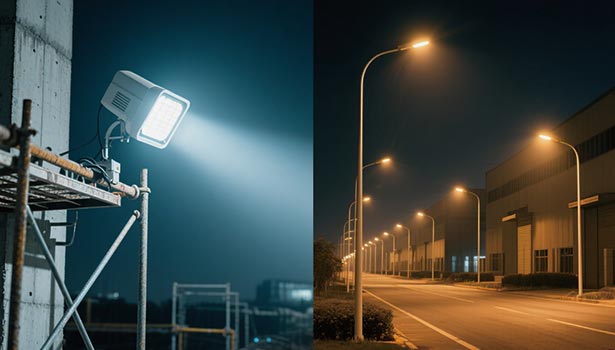
When to Use Flood Lights vs Street Lights?
Commercial Applications
Floodlights are suitable for shopping mall facades, billboard areas and hypermarket loading zones. Installation of flood lights on shopping mall walls can highlight the three-dimensional sense of architecture and design aesthetics through multi-angle irradiation, forming a unique landmark at night, attracting customers; billboard area with flood lighting can make the content clear and eye-catching, enhancing the attractiveness of the supermarket unloading area due to the trucks in and out of the goods handling frequently, flood lights can allow staff to see the goods placement and vehicle parking location, improve efficiency and reduce errors.
Commercial street walking channel is more suitable for the installation of street lights, its continuous soft light can make pedestrians feel comfortable when shopping, to avoid glare stimulation, while illuminating the store front, convenient for customers to identify and enhance the experience.
Industrial Settings
Floodlights are widely used in the industrial field due to their wide beam and strong brightness. In addition to manufacturing factories and warehouses, large outdoor industrial locations such as shipyards and open-air work areas in mines are also indispensable. These places are huge equipment, wide range of operations, the floodlight's wide beam can cover the complex corners, so that workers in welding, assembly, mining and other operations to see the details, to protect the quality and safety.
Precision assembly line operation inside the workshop, if the ordinary lighting is not enough light, with low-power floodlights for local supplemental lighting, so that workers are more clear parts assembly, testing and other work to reduce product defects and improve production efficiency.
Public Spaces
Lighting for public spaces needs to be both functional and comfortable. Streets and highways are the main position of street lights, and their specially designed light distribution can ensure a clear view of the vehicle driving, reducing the rate of traffic accidents at night. Residential neighborhoods, the main street lights for residents to walk at night, driving to provide security, and light intensity moderate, does not affect the rest; community center square, leisure pavilion and other areas to install floodlights, can create a warm and lively atmosphere, convenient for residents to carry out square dancing, chatting and other activities.
Scenic lighting focuses on the landscape effect, street lights on both sides of the trail can guide visitors to tour in an orderly manner to avoid getting lost; scenic landmarks, rockeries, lakes and other landscapes, with floodlights focusing on lighting, can be shown at night with the daytime aesthetic different from that of the night, to enhance the experience of tourists traveling at night, to attract more people to visit.
Selection Guide for Floodlights and Street Lights
Decision-Making According to the Scene Type
Choose 30-50W floodlights for private yards, mounted on fences or eaves, illuminating flowers and plants and softly; use 8-12m high-pole street lights with 100-120W on main roads in cities to ensure full illumination of road surfaces and safeguard driving safety; campus playgrounds need 200-300W high-brightness floodlights mounted on the periphery to meet The campus playground needs 200-300W high-brightness floodlights installed around it to meet nighttime activities, while the campus roads use 6-8 meters high, 50-80W street lights to provide stable and soft light.
Assessing Lighting Needs in Detail
First, measure the length, width and height of the area to calculate the coverage area. If the area is irregular and has a lot of obstacles, choose floodlights with wide beams to illuminate the corners; and use street lights with narrow beams for long and narrow roads to project accurately and avoid wastage. In terms of light intensity, 400-500W floodlights are needed in high-precision operation areas such as ports; 50-80W street lights are used in roads around residential areas to avoid affecting residents.
Comprehensive Cost Estimation
Selection of lights and lanterns need to be comprehensive cost. Floodlights are easy to install, convenient wiring, and low cost; street lights need to be installed with high poles, complicated line laying and commissioning, and high installation cost. Maintenance, high street light position, maintenance needs professional equipment, high cost, priority for durable LED street lights; flood light position is low, maintenance is convenient and low cost, but still need to choose quality and reliable products. Comprehensive accounting of the preliminary and long-term expenditure, choose cost-effective program.
Floodlights and street lights are outdoor lighting equipment, but each has a clear division of labor: floodlights to high-intensity, wide-range light focus on a specific area to meet the targeted lighting needs from private yards to large industrial sites and other scenarios; street lights are focused on the public road, through the orderly distribution of light for pedestrians and vehicles to provide continuous lighting to ensure the safety of passage. When choosing, you need to combine specific scenes, lighting needs details and cost considerations, so that the two have their respective roles, you can ensure the safety and convenience of the night at the same time, to achieve energy-saving and cost optimization.

